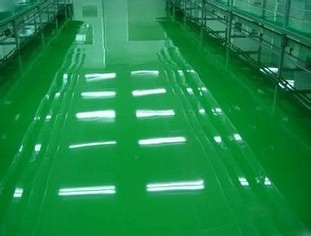How to choose floor paint
 Floor paint is ideal for environments where hygiene and durability are crucial, such as the floors of food processing plants, pharmaceutical facilities, laboratories, equipment rooms, and areas requiring anti-corrosion, anti-wear, and chemical resistance—like underground parking lots, warehouses with forklift traffic, and industrial zones. Choosing the right type of floor coating not only ensures long-term performance but also helps manage construction costs effectively. Here’s how to make an informed decision:
First, consider the mechanical performance needs:
1. **Wear Resistance**: What kind of vehicles or equipment will be used on the floor? Heavy machinery or forklifts require stronger coatings.
2. **Load Capacity**: How much weight will the floor support over time? This affects the thickness and material choice.
3. **Impact Resistance**: Will the floor be exposed to heavy drops or impacts that could cause peeling or cracking?
Second, evaluate the chemical resistance requirements:
1. **Acid and Alkali Resistance**: What chemicals are commonly used in the environment? High concentrations may require specialized coatings.
2. **Solvent Resistance**: How long will the floor be in contact with solvents or cleaning agents? Some coatings are more resistant than others.
Third, take into account the location of the floor:
Is it located underground or on a ground level? Underground floors often need moisture-resistant coatings, while ground-level floors may require different treatments based on humidity levels.
Fourth, assess the condition of the base surface:
1. **Base Strength**: The substrate should have a compressive strength of at least 20 MPa.
2. **Flatness**: If the surface is uneven, you might need to use epoxy mortar for leveling before applying the coating.
Fifth, think about aesthetic preferences:
1. **Color Choice**: Do you want a solid color, patterned design, or a specific brand color?
2. **Finish Type**: Choose between matte, semi-gloss, or high-gloss finishes depending on the desired look and maintenance needs.
3. **Surface Smoothness**: Are there any flatness requirements for the final appearance?
Sixth, some applications require additional features like **anti-static properties** or **fire resistance**, especially in sensitive areas such as cleanrooms or data centers.
Seventh, consider your **budget**. The cost can vary significantly based on the type of coating, thickness, and application method. It's important to balance quality and affordability.
Lastly, **safety** is key. In oily environments or on ramps, non-slip coatings are essential to prevent accidents and ensure worker safety.
By carefully evaluating these factors, you can select the most suitable floor paint solution that meets both functional and aesthetic needs while staying within your budget.
Floor paint is ideal for environments where hygiene and durability are crucial, such as the floors of food processing plants, pharmaceutical facilities, laboratories, equipment rooms, and areas requiring anti-corrosion, anti-wear, and chemical resistance—like underground parking lots, warehouses with forklift traffic, and industrial zones. Choosing the right type of floor coating not only ensures long-term performance but also helps manage construction costs effectively. Here’s how to make an informed decision:
First, consider the mechanical performance needs:
1. **Wear Resistance**: What kind of vehicles or equipment will be used on the floor? Heavy machinery or forklifts require stronger coatings.
2. **Load Capacity**: How much weight will the floor support over time? This affects the thickness and material choice.
3. **Impact Resistance**: Will the floor be exposed to heavy drops or impacts that could cause peeling or cracking?
Second, evaluate the chemical resistance requirements:
1. **Acid and Alkali Resistance**: What chemicals are commonly used in the environment? High concentrations may require specialized coatings.
2. **Solvent Resistance**: How long will the floor be in contact with solvents or cleaning agents? Some coatings are more resistant than others.
Third, take into account the location of the floor:
Is it located underground or on a ground level? Underground floors often need moisture-resistant coatings, while ground-level floors may require different treatments based on humidity levels.
Fourth, assess the condition of the base surface:
1. **Base Strength**: The substrate should have a compressive strength of at least 20 MPa.
2. **Flatness**: If the surface is uneven, you might need to use epoxy mortar for leveling before applying the coating.
Fifth, think about aesthetic preferences:
1. **Color Choice**: Do you want a solid color, patterned design, or a specific brand color?
2. **Finish Type**: Choose between matte, semi-gloss, or high-gloss finishes depending on the desired look and maintenance needs.
3. **Surface Smoothness**: Are there any flatness requirements for the final appearance?
Sixth, some applications require additional features like **anti-static properties** or **fire resistance**, especially in sensitive areas such as cleanrooms or data centers.
Seventh, consider your **budget**. The cost can vary significantly based on the type of coating, thickness, and application method. It's important to balance quality and affordability.
Lastly, **safety** is key. In oily environments or on ramps, non-slip coatings are essential to prevent accidents and ensure worker safety.
By carefully evaluating these factors, you can select the most suitable floor paint solution that meets both functional and aesthetic needs while staying within your budget.A walking support and a horizontally moving oil cylinder are arranged under the main body of the gantry. Inverted arch side templates are arranged on both sides of the main body of the gantry, so that the gantry can move back and forth, left and right. The tunnel inverted arch self-propelled frame has a simple structure, low cost, and low failure rate. While ensuring vehicle traffic, inverted arch construction can be carried out, which can effectively ensure the construction speed of the tunnel and effectively reduce construction accidents.
Inverted Arch Trestle Trolley,Electric Trestle Trolley,Arch Trestle Trolley,Hydraulic Inverted Arch Trolley
Anshan Lijian Engineering Group Co. LTD , https://www.lijianformwork.com